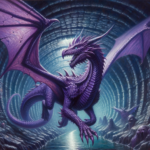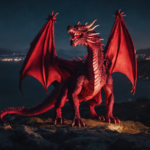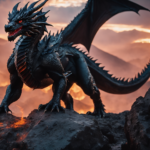Shadow Dragons – an Overview:
Shadow Dragons, also known as Malevolent Dragons, are enigmatic and formidable mythical beings that dwell in the darkest corners of the imagination. These elusive creatures are often associated with darkness, secrets, and malevolent energy. In this fact file, we delve into the mysterious world of Shadow Dragons, exploring their unique characteristics, habitats, and their role as bringers of darkness amongst Elemental Dragons.
Physical Characteristics:
- Scales: Shadow Dragons possess scales that are as black as the deepest abyss, granting them an uncanny ability to blend seamlessly into the shadows.
- Size: They typically exhibit impressive size, with powerful bodies that exude an aura of foreboding.
- Horns: Many of these Dragons are adorned with menacing, twisted horns that add to their sinister appearance.
- Eyes: Their eyes, like pools of darkness, radiate malevolent energy, instilling fear and unease in those who meet their gaze.
- Wings: With expansive and leathery wings, Shadow Dragons navigate the dark recesses of the world with eerie grace.
Habitat:
- Caverns of Despair: Shadow Dragons are often associated with caverns hidden deep within the earth, where they brood in solitude amidst the pitch-black darkness.
- Haunted Forests: Legends speak of them inhabiting ancient, haunted forests, where the very trees seem to whisper their secrets.
- Abyssal Realms: In some myths, these dragons are said to have domains in shadowy abyssal realms that exist beyond mortal comprehension.
Behaviour and Abilities:
- Malevolence: Shadow Dragons are beings of malevolence and darkness. They are feared for their malicious intent and their ability to corrupt the hearts of those who come into contact with them.
- Dark Breath: Their breath weapon is often a conduit for malevolent energy, capable of unleashing torrents of darkness that can obscure vision and consume all light.
- Shadow Manipulation: These Dragons are masters of manipulating shadows, allowing them to move stealthily and strike from the darkness.
- Phasing Abilities: Some legends attribute phasing abilities to Shadow Dragons, enabling them to pass through solid objects and evade capture.

Cultural Significance of Shadow Dragons:
- Harbingers of Doom: In many cultures, Shadow Dragons are seen as harbingers of doom, associated with impending disasters and calamities.
- Symbols of Fear: They serve as symbols of fear and the consequences of straying from the path of righteousness.
- Dark Rituals: In certain mythologies, cults worship them, invoking their malevolent power for dark rituals and nefarious purposes.
Legends and Stories:
- The Curse of the Shadowed Kingdom: A chilling legend tells of a Shadow Dragon that cursed an entire kingdom, shrouding it in eternal darkness until a hero emerged to confront the beast.
- The Whispering Forest: In haunted forests where Shadow Dragons are said to dwell, tales speak of eerie whispers and spectral apparitions that guard their lairs.
- The Darkness Within: Some stories explore the internal struggle of individuals who have encountered Shadow Dragons, highlighting the corrupting influence of malevolence.
Shadow Dragons – a Conclusion:
Shadow Dragons, with their ominous presence and mastery over darkness, are enduring symbols of humanity’s fascination with the enigmatic and mysterious. They serve as cautionary figures, reminding us of the consequences of succumbing to malevolence and straying from the path of light. In their shadowy majesty, these mythical beings continue to inspire fear, awe, and a sense of the unknown, reminding us that darkness is an integral part of the intricate tapestry of mythical creatures.
For more great Dragon content please subscribe to our YouTube Channel or follow the Everything Dragon Instagram




